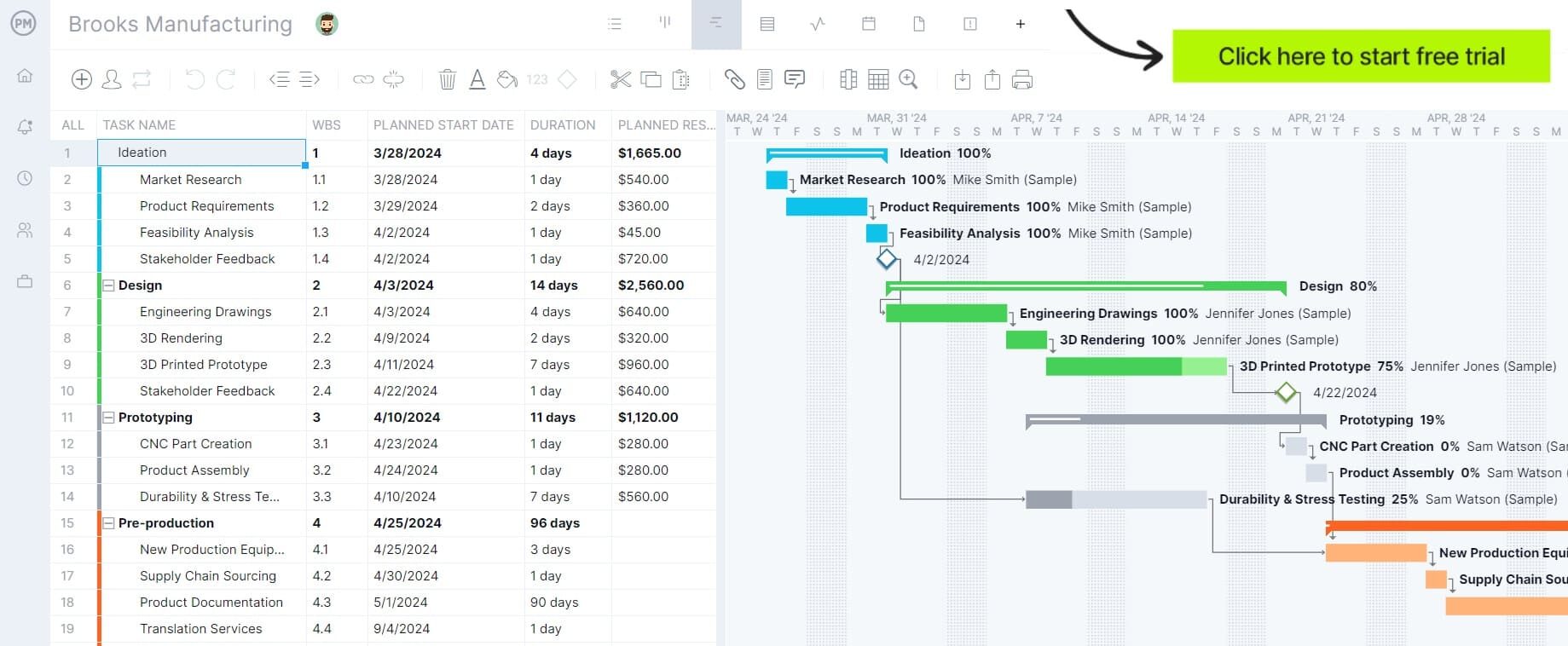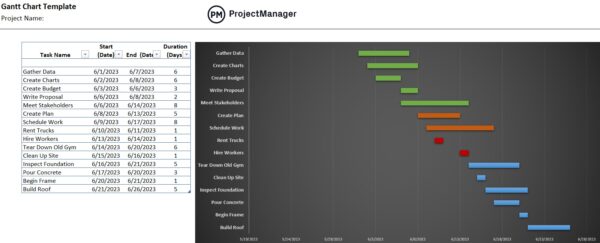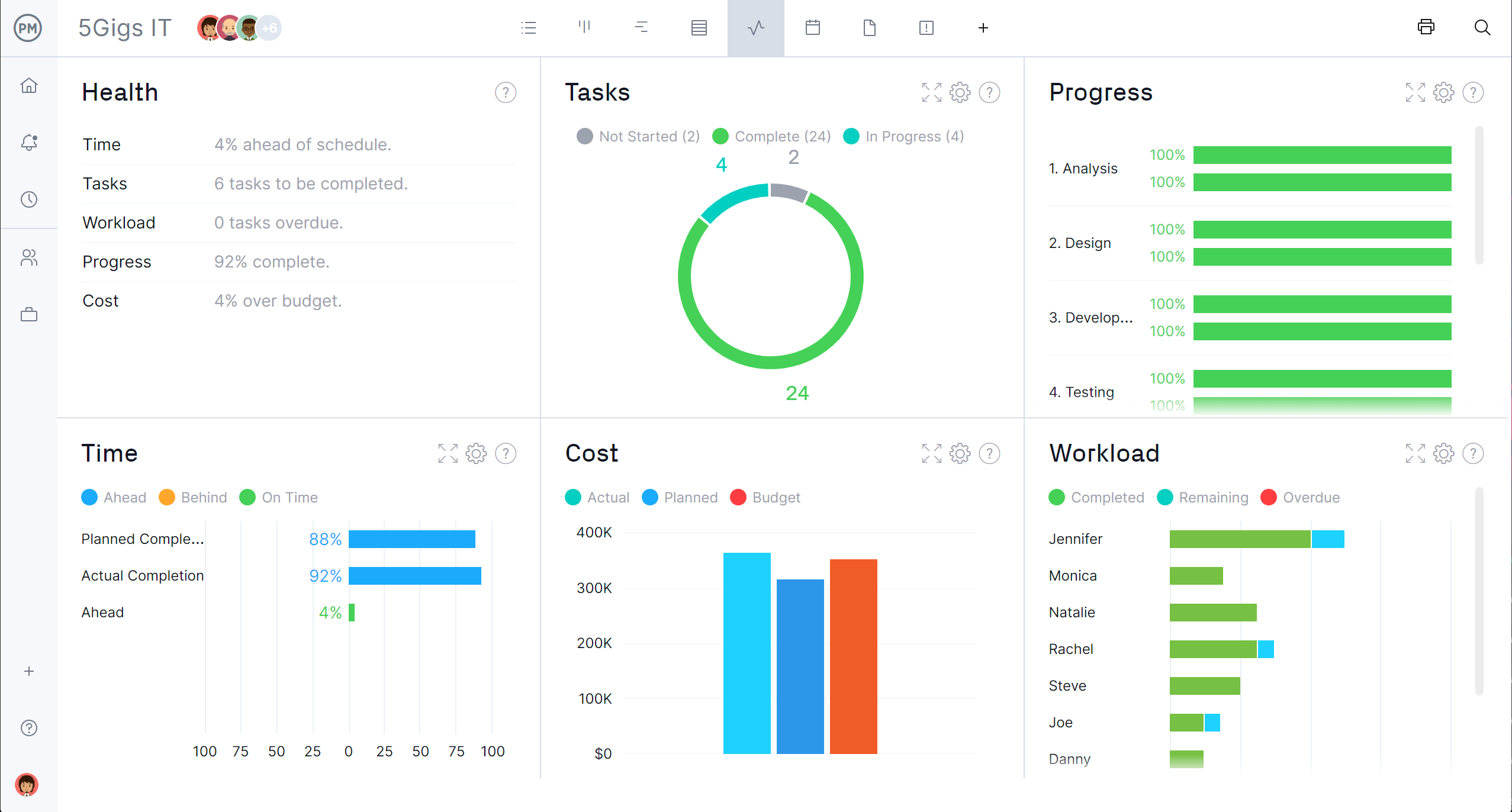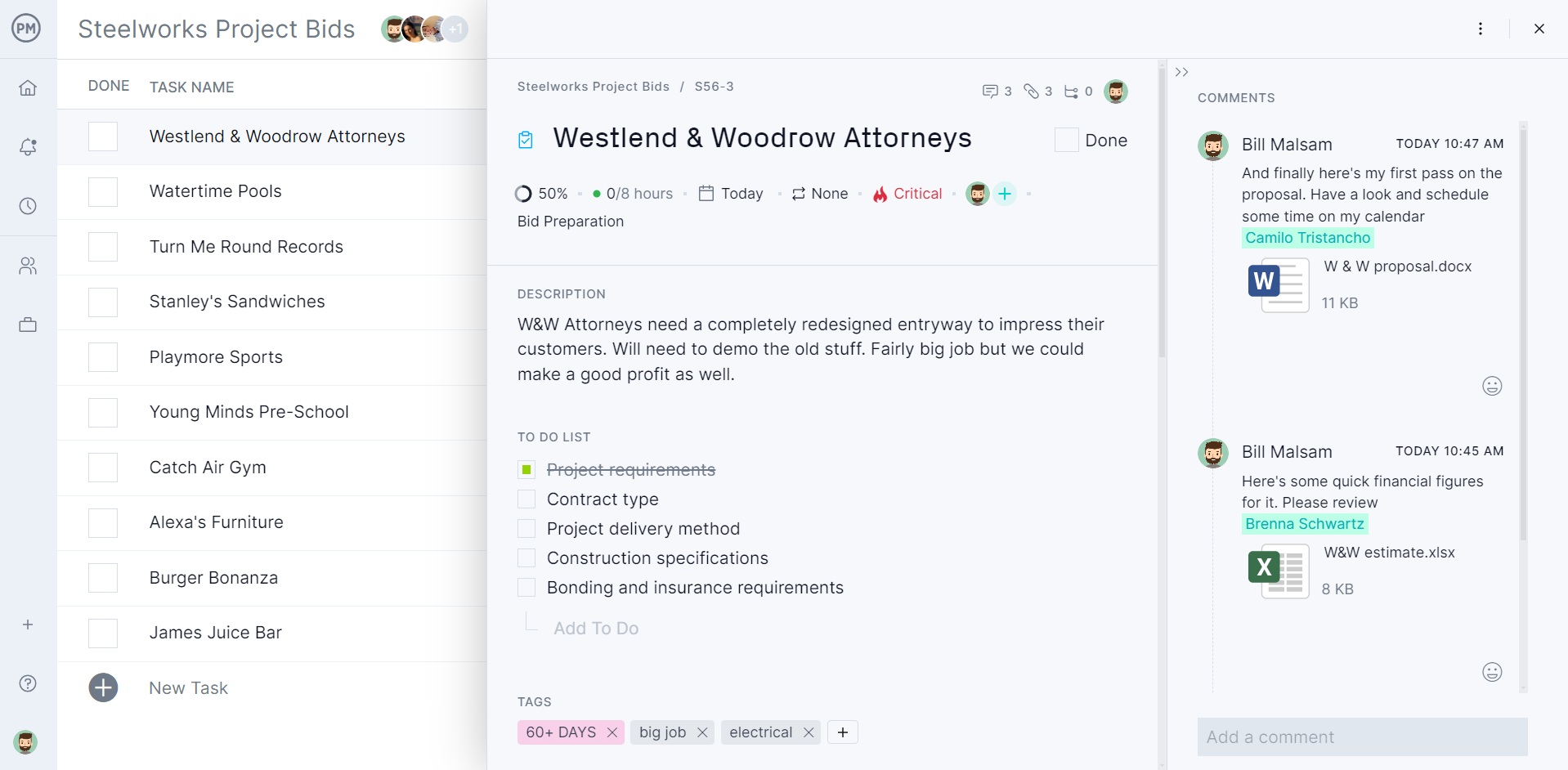You’re likely eager to meet your goals, whether they’re personal or professional. Without an action plan, however, there’s no roadmap on how to get there. This is where a well-designed plan can make it easier to track and meet your goals.
What Is an Action Plan?
In project management, an action plan is a document that lists the action steps needed to achieve project goals and objectives. Therefore, it clarifies what resources you’ll need to reach those goals, makes a timeline for the action items and determines what team members are required. We’ll define what project goals, project objectives, action items and action steps are later in this guide.
An action plan is similar to a project implementation plan, and it’s very helpful during the project planning and project execution phases. That’s because an action plan documents the execution of the project plan; it’s a detailed list of the work that must be done to complete the project goals, from the start of the project to the finish.
Not only are you figuring out the action steps and timeline, but you’ll also determine who you’ll assemble for your project team to work on those tasks. This requires robust project management software like ProjectManager. ProjectManager offers multiple planning tools such as Gantt charts, kanban boards, project calendars and more. Best of all, these project planning views sync with project dashboards, timesheets and workload charts to keep track of progress, project resources and costs.

What Is the Purpose of an Action Plan?
The main goal of an action plan is to outline the resources and timeline needed to reach the project’s goals. It helps clarify objectives and provides a clear vision of the desired outcome. As the name suggests, it breaks down the goal into actionable steps and assigns responsibilities, so everyone on the team understands the key deadlines and how resources will be used.
Beyond the logistics, an action plan also provides a framework to track progress and adjust to stay on track. For example, if the goal is to launch a new product by Nov. 1 but market research isn’t finished until Oct. 25th, the plan will need to be adjusted accordingly. If risks develop along the way, contingency plans can mitigate any adverse outcomes. Finally, it provides a basis for measuring success once the goals are achieved.
Who Should Make Action Plans?
While project managers use action plans, other team leaders and business managers who execute a project or a process can also use them. Action plans can be used alone or with a team; in scenarios where the team is involved, the leader will assemble the plan and gather everyone’s input.
Here’s an overview of who should be involved in creation and implementation:
- Project Management Professionals: Project, program and project portfolio managers and project management offices (PMOs)
- Business Operations Management Teams: Department heads, functional managers and supervisors
- Organizational Planning Teams: Top management team, executives, board of directors and project sponsors
For example, the project manager will develop the action plan to oversee the project from start to finish. This ensures the project is executed on track and within scope. Project sponsors will look over the plan to confirm that it aligns with strategic goals, and stakeholders will use it to stay informed on the overall progress and how it impacts their interests.
Action Plan vs. Project Plan
While action plans and project plans are two important project management tools, they’re used differently. An action plan narrows the steps needed to achieve a particular goal. It’s often used for small tasks or project initiatives. Components of an action plan include tasks, responsibilities, deadlines, resources and status. For example, an action plan for launching a new product includes market research, product development and a plan to launch the product into the market.
A project plan, on the other hand, is an overarching framework of how to manage a project from beginning to end. It‘s broader in scope and covers all areas of the project. Components of the project plan include objectives, scope statement, work breakdown structure (WBS), schedule, budget, risk management plan, communication plan and quality plan.
Action Plan Components
An action plan answers the who, what and when of what you’re proposing. Those questions are answered by the various components that make up the plan. The following are the basic building blocks of a successful plan.
- Goals and Objectives: Before you make any plan, set goals and objectives. It’s key to understand what you are trying to achieve before you start defining steps to get there.
- Action Steps: These steps are the answer to the question of what. They’re the activities that’ll lead to achieving your goal. Steps detail what will happen, and the more detail, the better.
- Action Items: The action items are the specific, small tasks that make up the action plan steps. These are the tasks that, when executed, lead to the next step. It’s important to define the priority level of these action items as well as the deliverables expected from them.
- Timeline: A timeline is the whole action plan laid out from start to finish. It shows the full duration and every step and task is also plotted on this timeline, including their start and end dates.
- Resources: Resources are anything needed to execute the action plan. That includes labor, materials, equipment, etc. You’ll want to identify the resources you’ll need and attach them to the tasks to which they’ll be applied.
- Costs: Resources, such as people and equipment, are going to cost money. Be sure to identify the costs that are obvious or hidden deep within your action plan.
- Action Plan Matrix: A matrix is just a tool to help you determine which tasks you need to complete and in what order. Use our free action plan template to outline the steps, items, timeline and resources you’ll need to get the plan done right.
- Action Plan Report: You’ll need to ensure your actual progress matches your planned progress. To track progress, you’ll want to use an action plan report, which is a snapshot of your time, costs and more over a specific period.

Get your free
Action Plan Template
Use this free Action Plan Template for Excel to manage your projects better.
Types of Action Plans
There are many different types of action plans that are used on various kinds of strategic initiatives. Each is similar in makeup but differs in their goals. Here are a few of the varieties.
Business Action Plan
A business action plan is used to set goals and tasks when you want to start a business or grow an existing business. It outlines the vision for the business and the actions you’ll take to achieve that vision.
Project Action Plan
An action plan for a project is really no different from a general action plan. The only difference is that it’s about producing a deliverable at the end of the plan, whether that be a product or service.
Personal Action Plan
Again, a personal action plan differs little from any other, except for the goal. For example, a personal action plan might be for an individual to exercise more. Therefore, the goal might be to walk for a half-hour a day, say, during lunchtime.
How to Write an Action Plan for Project Management in 10 Steps
The benefits of an action plan are simple: you’ve now outlined what action steps and what resources are needed to reach your stated project goals. By having this collected in a single project management document, you can more successfully plan out how to execute your project plan.
People get overwhelmed by project management jargon when having to plan out a project, but the word “action” everyone can understand. The fundamentals to getting an action plan together for any project follow these four project planning basic steps:
1. Define Your Project Goals
There’s a difference between project goals and project objectives. Project goals refer to the high-level goals that the project will achieve. Those generally align with the strategic planning and business objectives of organizations.
2. Define Your Project Objectives
The project objectives are much more specific than the project goals. Project objectives refer to the deliverables and milestones that need to be completed to achieve your project goals.
3. Define Action Steps
The action steps are a group of related tasks or action items that must be executed to produce project deliverables.
4. Identify and Prioritize Action Items
Action items are small, individual tasks that make up the action steps that are outlined in your action plan. First, you need to identify task dependencies among them, and then assign those action items a priority level so that they’re executed sequentially.
5. Define Roles & Responsibilities
Now that you’ve divided the work required to accomplish your action plan, you’ll need to assign action items to your project team members and define their roles and responsibilities.

6. Allocate Resources
As with your project plan, your action plan has resource requirements. Having identified your action steps and action items will help you understand what resources are needed for each task and allocate them accordingly.
7. Set SMART Goals
Your action plan needs to be monitored and controlled to measure its performance. That’s why it’s important that you set SMART goals for your action items, action steps and your project objectives. SMART goals stand for specific, measurable, attainable, relevant and timely.
8. Set a Timeline for Your Action Plan
As a project manager, you’ll need to do your best to estimate how long it’ll take to complete your action items and action steps. Once you do so, you’ll have a timeline. You can use project management techniques like PERT charts or the critical path method to better estimate the duration of your project action plan.

9. Write an Action Plan Template
Create or use a simple action plan template to collect tasks, deadlines and assignments. This is the place where everything task-related goes in your project action plan, so you have a place for all this crucial information.
Writing an action plan template it’s a great idea because you’ll need to use that format throughout the project. That’s why we’ve created a free action plan template that you can download. There are also dozens of other free project management templates for Excel and Word that can help you with every phase of your project.
10. Use a Project Management Tool
Use a project management tool to keep you on task. ProjectManager has project planning features that help you monitor and report on project progress and performance. Get a high-level view of the action plan with our live dashboards. Unlike other tools, we don’t make you set up the dashboard.
Once you’ve mapped out your action plan, you can use project planning tools to zoom into all the details about your action steps and action items. With ProjectManager, you can calculate various metrics, such as project variance, workload and more. They’re displayed in easy-to-read charts and graphs. Share them with stakeholders to give them updates on action steps whenever they want.

Action Plan Example
We’ve been talking a lot about action plans, but the best way to learn how they work is to review an action plan example. Below, you’ll see our free action plan template. It’s set up for the development of a website.
Example Goals & Objectives
The first thing to do when making an action plan is to clearly define its goals and objectives. Objectives are the specific accomplishments or outcomes that are needed to achieve the larger goals, as shown in the image below.

Example Action Steps
Then, once these have been defined, the action plan is broken down into four action steps: market research, website development, site launch and site maintenance. You’ll see that specific tasks or action items are outlined for each action step, including a description of that task, who’s assigned to execute it, its priority level and even the status of its completion.

Example Action Plan Timeline
There’s also a timeline to define the start dates of each of the tasks in the action steps, including the planned hours. This allows you to determine the length of each task and the duration of the entire action plan, from start to finish.

Example Resources
Finally, there’s a place to add your resources. They’re broken down into departments, for example, marketing, web development, etc. Then the materials that are required for each task are listed, including their costs. This allows you to estimate the cost of the plan.

How to Make An Action Plan With ProjectManager
See how action plans are typically laid out using project planning software.
1. Plan with Multiple Project Views
ProjectManager can help you build your action plan and then execute it. Collect all your action steps tasks on our list view, which does more than light-weight to-do list apps because it allows you to then map your plan with Gantt charts, project calendars and kanban boards. These robust project management tools allow you to prioritize action items, customize tags and show the percentage complete for each task. Our online project management software gives you real-time data to help you create an action plan and stick to it.

2. Assign Action Items to Your Team Members
Once you’ve mapped out your action plan steps with ProjectManager’s project planning tools, you can assign tasks to your team members and indicate what resources are needed for the completion of each action item. Indicate their roles and responsibilities and set priority levels for each task to ensure the work is carried out properly.
3. Set Action Plan Steps and Deliverables
It’s important to note all the phases of the project timeline to know what action steps and tasks will take place and when. In addition, ProjectManager’s Gantt chart allows you to identify project phases, find the critical path, and set due dates for project milestones and deliverables
4. Track Progress With Real-Time Dashboards
Once you start the project, you’ll need to chart the progress of the work being done. This leads us to the real-time project dashboard, where you’ll check whether your action plan is on schedule and under budget.
Manage Your Project With an Action Plan
Getting a plan together is only the first part of managing a project. Remember, it’s not something to write and put away, but rather it’s a living document that should follow you throughout the project life cycle. Jennifer Bridges, PMP, offers more tips on how to write an action plan in the video below.
Here’s a screenshot for your reference:

Related Planning Content
- Contingency Plan Template
- Corrective Action Plan Template
- What Is Contingency Planning? Creating a Contingency Plan
- What Is an Implementation Plan? (Template & Example Included)
- What Is a Work Plan? How to Make a Work Plan
ProjectManager gives you all the tools you need to create and implement a successful plan. Regardless of the type of action plan that you need to create, our award-winning project management software makes it easy to do so. Get started with a free 30-day trial today.

